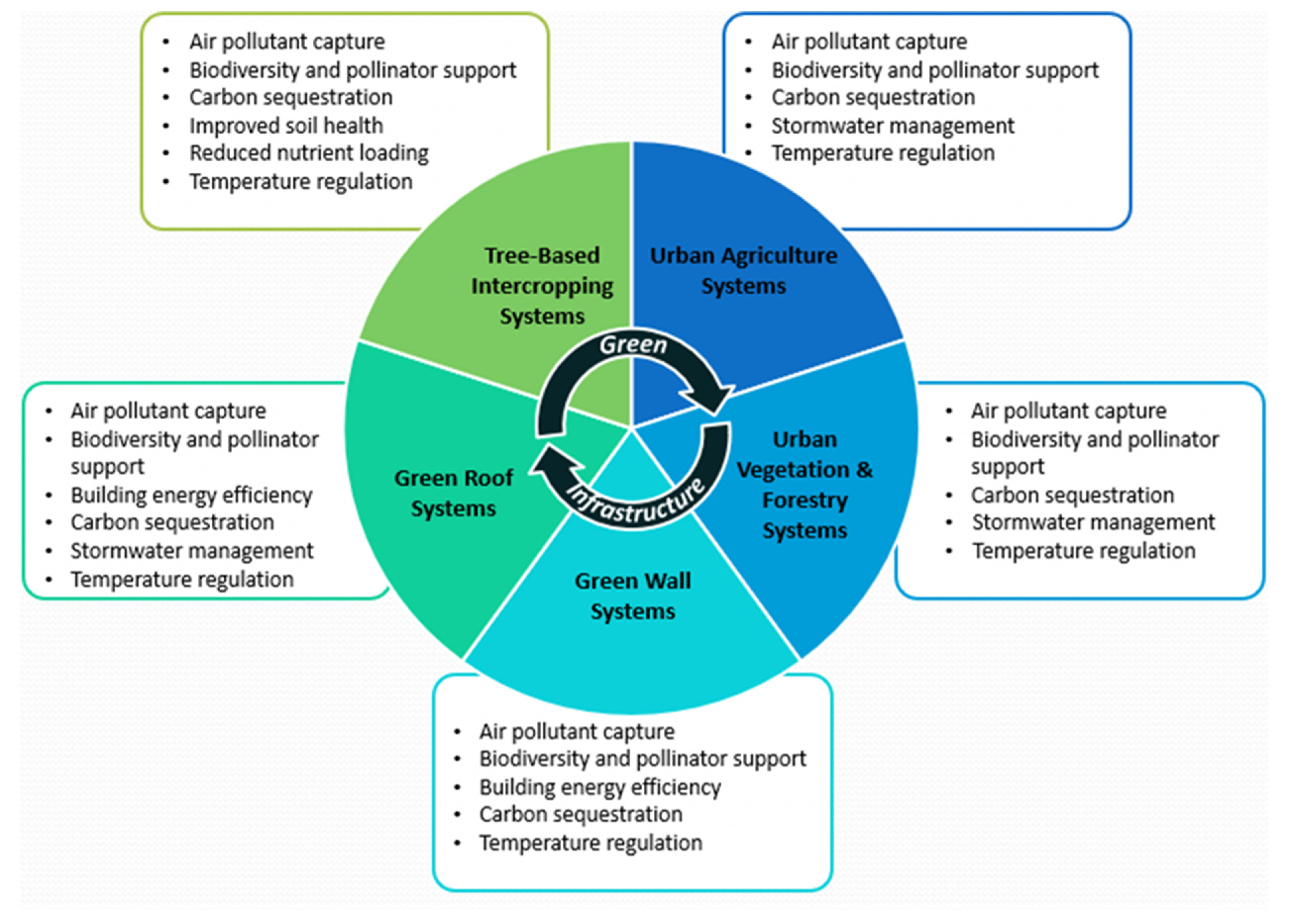Nature-Based Equity: An Assessment of the Public Health Impacts of Green Infrastructure in Ontario Canada
Abstract
1. Introduction
2. Methods
2.1. Participants
2.2. Data Collection
2.3. Data Analysis
2.4. Study Limitations
3. Results
3.1. Vulnerable Populations
3.2. Norms, Attitudes and Beliefs about Green Infrastructure
3.3. Green Infrastructure Access and Usage
3.4. Relevant Messaging
4. Discussion
- Public health units as it relates to environmental health and the impacts of the natural and built environment on population health including heat stress, air quality and food security;
- Municipal planning departments as it relates to new development, building retrofits and re-zoning including energy efficiency, stormwater management, and extreme weather events; and
- Provincial and federal government ministries as it relates to government priorities such as climate change mitigation and adaptation; increased food security; and improved air and water quality.
Future Research
5. Conclusions
Author Contributions
Funding
Institutional Review Board Statement
Informed Consent Statement
Data Availability Statement
Conflicts of Interest
References
- Cohen-Shacham, E.; Walters, G.; Janzen, C.; Maginnis, S. (Eds.) Nature-Based Solutions to Address Global Societal Challenges; IUCN: Gland, Switzerland, 2016; ISBN 978-2-8317-1812-5. [Google Scholar]
- Cohen-Shacham, E.; Andrade, A.; Dalton, J.; Dudley, N.; Jones, M.; Kumar, C.; Maginnis, S.; Maynard, S.; Nelson, C.R.; Renauda, F.G. Core principles for successfully implementing and upscaling Nature-based Solutions. Environ. Sci. Policy 2019, 98, 20–29. [Google Scholar] [CrossRef]
- Seddon, N.; Chausson, A.; Berry, P.; Girardin, C.A.J.; Smith, A.; Turner, B. Understanding the value and limits of nature-based solutions to climate change and other global challenges. Philo. Trans. R. Soc. B 2020, 375, 20190120. [Google Scholar] [CrossRef]
- Anderson, V.; Gough, W.A. Evaluating the potential of nature-based solutions to reduce ozone, nitrogen dioxide, and carbon dioxide through a multi-type green infrastructure study in Ontario, Canada. City Environ. Interact. 2020, 6, 100043. [Google Scholar] [CrossRef]
- Anderson, V.; Gough, W. Harnessing the Four Horsemen of Climate Change: A Framework for Deep Resilience, Decarbonization, and Planetary Health in Ontario, Canada. Sustainability 2021, 13, 379. [Google Scholar] [CrossRef]
- Anderson, V.; Gough, W.A. Form, Function, and Nomenclature: Deconstructing Green Infrastructure and its Role in a Changing Climate. In Climate Change and Extreme Events, 1st ed.; Fares, A., Ed.; Elsevier: Amsterdam, The Netherlands, 2021; ISBN 9780128227008. [Google Scholar]
- Anderson, V. Dissertation: Deep Adaptation: A Framework for Climate Resilience, Decarbonization and Planetary Health in Ontario. 2018. Available online: https://tspace.library.utoronto.ca/ (accessed on 15 May 2021).
- Anderson, V.; Gough, W.A. Nature-based cooling potential: A multi-type green infrastructure evaluation in Toronto, Ontario, Canada. Int. J. Biometeorol. 2021. [Google Scholar] [CrossRef]
- Smith, K.; Woodward, A.; Campbell-Lendrum, D.; Chadee, D.; Honda, Y.; Liu, Q.; Olwoch, J.; Revich, B.; Sauerborn, R.; Aranda, C. Human health: Impacts, adaptation, and co-benefits. In Climate Change 2014: Impacts, Adaptation, and Vulnerability. Part A: Global and Sectoral Aspects. Contribution of Working Group II to the Fifth Assessment Report of the Intergovernmental Panel on Climate Change; Field, C.B., Barros, V.R., Dokken, D.J., Mach, K.J., Mastrandrea, M.D., Bilir, T.E., Chatterjee, M., Ebi, K.L., Estrada, Y.O., Genova, R.C., et al., Eds.; Cambridge University Press: Cambridge, UK; New York, NY, USA, 2014; pp. 709–754. [Google Scholar]
- Watts, N.; Adger, W.N.; Agnolucci, P.; Blackstock, J.; Byass, P.; Cai, W.; Chaytor, S.; Colbourn, T.; Collins, M.; Cooper, A.; et al. Health and climate change: Policy responses to protect public health. Lancet 2015, 386, 1861–1914. [Google Scholar] [CrossRef]
- Watts, N.; Amann, M.; Arnell, N.; Ayeb-Karlsson, S.; Beagley, J.; Belesova, K.; Boykoff, M.; Byass, P.; Cai, W.; Campbell-Lendrum, D.; et al. The 2020 report of The Lancet Countdown on health and climate change: Responding to converging crises. Lancet 2021, 397, 129–170. [Google Scholar] [CrossRef]
- Séguin, J.; Berry, P.; Bouchet, V.; Clarke, K.L.; Furgal, C.; Environmental, I.; MacIver, D. (Eds.) Human Health in a Changing Climate: A Canadian Assessment of Vulnerabilities and Adaptive Capacity; Government of Canada: Ottawa, ON, Canada, 2008.
- Warren, F.J.; Lemmen, D.S. (Eds.) Canada in a Changing Climate: Sector Perspectives on Impacts and Adaptation; Government of Canada: Ottawa, ON, Canada, 2014; 286p.
- Gough, W.A.; Anderson, V.; Herod, K. Ontario Climate Change and Health Modelling Study: Report; Ontario Ministry of Health and Long-Term Care, Queen’s Printer for Ontario: Toronto, ON, Canada, 2016; ISBN 978-1-4606-7703-2. [CrossRef]
- Ebi, K.; Anderson, V.; Berry, P.; Paterson, J.; Yusa, A. Ontario Climate Change and Health Vulnerability and Adaptation Assessment Guidelines: Technical Document; Ontario Ministry of Health and Long-Term Care, Queen’s Printer for Ontario: Toronto, ON, Canada, 2016; ISBN 978-1-4606-6228-1. Available online: http://www.health.gov.on.ca/en/common/ministry/publications/reports/climate_change_toolkit/climate_change_health_va_guidelines.pdf (accessed on 15 May 2021).
- Buchin, O.; Hoelscher, M.T.; Meier, F.; Nehls, T.; Ziegler, F. Evaluation of the health-risk reduction potential of countermeasures to urban heat islands. Energy Build. 2016, 114, 27–37. [Google Scholar] [CrossRef]
- Nowak, D.; Crane, D.; Stevens, J.C. Air pollution removal by urban trees and shrubs in the United States. Urban For. Urban Green. 2006, 4, 115–123. [Google Scholar] [CrossRef]
- Nowak, D.J.; Hirabayashi, S.; Doyle, M.; McGovern, M.; Pasher, J. Air pollution removal by urban forests in Canada and its effect on air quality and human health. Urban For. Urban Green. 2018, 29, 40–48. [Google Scholar] [CrossRef]
- Tzoulas, K.; Korpela, K.; Venn, S.; Yli-Pelkonen, V.; Kazmierczak, A.; Niemela, J.; James, P. Promoting ecosystem and human health in urban areas using green infrastructure: A literature review. Landsc. Urban Plan. 2007, 81, 167–178. [Google Scholar] [CrossRef]
- Susca, T.; Gaffin, S.R.; Dell’Osso, G.R. Positive effects of vegetation: Urban heat island and green roofs. Environ. Pollut. 2011, 159, 2119–2126. [Google Scholar] [CrossRef] [PubMed]
- Liang, T.C.; Wong, N.H.; Jusuf, S.K. Effects of vertical greenery on mean radiant temperature in the tropical urban environment. Landsc. Urban Plan. 2014, 127, 52–64. [Google Scholar]
- Chen, D.; Wang, X.; Thatcher, M.; Barnett, G.; Kachenko, A. Urban Vegetation for reducing heat related mortality. Environ. Pollut. 2014, 192, 275–284. [Google Scholar] [CrossRef] [PubMed]
- King, K.; Johnson, S.; Kheirbek, I.; Lu, J.; Matte, T. Differences in magnitude and spatial distribution of urban forest pollution deposition rates, air pollution emissions, and ambient neighborhood air quality in New York City. Landsc. Urban Plan. 2014, 128, 14–22. [Google Scholar] [CrossRef]
- Rao, M.; George, L.; Rosenstiehl, T.N.; Shandas, V.; Dinno, A. Assessing the relationship among urban trees, nitrogen dioxide, and respiratory health. Environ. Pollut. 2014, 194, 96–104. [Google Scholar] [CrossRef]
- Speak, A.F.; Rothwell, J.J.; Lindley, S.J.; Smith, C.L. Urban particulate pollution reduction by four species of green roof vegetation in a UK city. Atmos. Environ. 2012, 61, 283–293. [Google Scholar] [CrossRef]
- Kessler, R. Urban gardening: Managing the risks of contaminated soil. Environ. Health Perspect. 2013, 121, 326–333. [Google Scholar] [CrossRef]
- Rowe, D.B. Green roofs as a means of pollution abatement. Environ. Pollut. 2011, 159, 2100–2110. [Google Scholar] [CrossRef] [PubMed]
- Ellis, J.B. Sustainable surface water management and green infrastructure in UK urban catchment planning. J. Environ. Plan. Manag. 2013, 56, 26–41. [Google Scholar] [CrossRef]
- Lin, B.; Philpott, S.M.; Jia, S. The future of urban agriculture and biodiversity-ecosystem services: Challenges and next steps. Basic Appl. Ecol. 2015, 16, 189–201. [Google Scholar] [CrossRef]
- Defries, R.S.; Foley, J.; Asner, G. Land-use choices: Balancing human needs and ecosystem function. Front. Ecol. Environ. 2004, 2, 249–257. [Google Scholar] [CrossRef]
- Goldberg, T.L.; Gillespie, T.R.; Rwego, I.B.; Estoff, E.L.; Chapman, C.A. Forest fragmentation as cause of bacterial transmission among nonhuman primates, humans, and livestock, Uganda. Emerg. Infect. Dis. 2008, 14, 1375–1382. [Google Scholar] [CrossRef]
- Ostfeld, R.S.; Keesing, F.; Eviner, V. Infectious Disease Ecology: Effects of Ecosystems on Disease and of Disease on Ecosystems; Princeton University Press: Princeton, NJ, USA, 2008. [Google Scholar]
- Gottdenker, N.L.; Streicker, D.G.; Faust, C.L.; Carroll, C.R. Anthropogenic land use change and infectious diseases: A review of the evidence. EcoHealth 2014, 11, 619–632. [Google Scholar] [CrossRef]
- Coutts, C.; Hahn, M. Green Infrastructure, Ecosystem Services, and Human Health. Int. J. Environ. Res. Public Health. 2015, 12, 9768–9798. [Google Scholar] [CrossRef]
- Stigsdotter, U.K.; Ekholm, O.; Schipperijn, J.; Toftager, M.; Kamper-Jørgensen, F.; Randrup, T.B. Health promoting outdoor environments–associations between green space, and health, health-related quality of life and stress based on a danish national representative survey. Scand. J. Public Health 2010, 38, 411–417. [Google Scholar] [CrossRef] [PubMed]
- Van den Berg, A.E.; Maas, J.; Verheij, R.A.; Groenewegen, P.P. Green space as a buffer between stressful life events and health. Soc. Sci. Med. 2010, 70, 1203–1210. [Google Scholar] [CrossRef] [PubMed]
- Berman, M.G.; Kross, E.; Krpan, K.M.; Askren, M.K.; Burson, A.; Deldin, P.J.; Kaplan, S.; Sherdell, L.; Gotlib, I.H.; Jonides, J. Interacting with nature improves cognition and affect for individuals with depression. J. Affect. Disord. 2012, 140, 300–305. [Google Scholar] [CrossRef] [PubMed]
- Beyer, K.M.; Kaltenbach, A.; Szabo, A.; Bogar, S.; Nieto, F.J.; Malecki, K.M. Exposure to neighborhood green space and mental health: Evidence from the survey of the health of Wisconsin. Int. J. Environ. Res. Public Health 2014, 11, 3453–3472. [Google Scholar] [CrossRef] [PubMed]
- Bratman, G.N.; Hamilton, J.P.; Hahn, K.S.; Daily, G.C.; Gross, J.J. Nature experience reduces rumination and subgenual prefrontal cortex activation. Proc. Nat. Acad. Sci. USA 2015, 112, 8567–8572. [Google Scholar] [CrossRef] [PubMed]
- WHO. Urban Green Spaces and Health—A Review of Evidence; World Health Organization Regional Office for Europe: Copenhagen, Denmark, 2016; Available online: https://www.euro.who.int/data/assets/pdffile/0005/321971/Urban-green-spaces-and-health-review-evidence.pdf (accessed on 28 December 2020).
- Reklaitiene, R.; Grazuleviciene, R.; Dedele, A.; Virviciute, D.; Vensloviene, J.; Tamosiunas, A.; Baceviciene, M.; Luksiene, D.; Sapranaviciute-Zabazlajeva, L.; Radisauskas, R.; et al. The relationship of green space, depressive symptoms and perceived general health in urban population. Scand. J. Public Health 2014, 42, 669–676. [Google Scholar] [CrossRef]
- Ulrich, R.S. View through a window may influence recovery from surgery. Science 1984, 224, 420–421. [Google Scholar] [CrossRef] [PubMed]
- Lee, J.; Tsunetsugu, Y.; Takayama, N.; Park, B.-J.; Li, Q.; Song, C.; Komatsu, M.; Ikei, H.; Tyrväinen, L.; Kagawa, T.; et al. Influence of Forest Therapy on Cardiovascular Relaxation in Young Adults. Evidence-Based Complement. Altern. Med. 2014, 2014, 1–7. [Google Scholar] [CrossRef]
- Song, C.; Ikei, H.; Miyazaki, Y. Physiological Effects of Nature Therapy: A Review of the Research in Japan. Int. J. Environ. Res. Public Health 2016, 13, 781. [Google Scholar] [CrossRef] [PubMed]
- Jo, H.; Song, C.; Miyazaki, Y. Physiological Benefits of Viewing Nature: A Systematic Review of Indoor Experiments. Int. J. Environ. Res. Public Health 2019, 16, 4739. [Google Scholar] [CrossRef] [PubMed]
- Villeneuve, P.J.; Jerrett, M.; Su, J.G.; Burnett, R.T.; Chen, H.; Wheeler, A.J.; Goldberg, M.S. A cohort study relating urban green space with mortality in Ontario, Canada. Environ. Res. 2012, 115, 51–58. [Google Scholar] [CrossRef] [PubMed]
- James, P.; Hart, J.E.; Banay, R.F.; Laden, F. Exposure to greenness and mortality in a nationwide prospective cohort study of women. Environ. Health Perspect. 2016, 124, 1344–1352. [Google Scholar] [CrossRef] [PubMed]
- Vienneau, D.; de Hoogh, K.; Faeh, D.; Kaufmann, M.; Wunderli, J.M.; Röösli, M. More than clean air and tranquillity: Residential green is independently associated with decreasing mortality. Environ. Int. 2017, 108, 176–184. [Google Scholar] [CrossRef]
- Crouse, D.L.; Pinault, L.; Balram, A.; Hystad, P.; A Peters, P.; Chen, H.; van Donkelaar, A.; Martin, R.V.; Ménard, R.; Robichaud, A.; et al. Urban greenness and mortality in Canada’s largest cities: A national cohort study. Lancet Planet. Health 2017, 1, e289–e297. [Google Scholar] [CrossRef]
- Tyler, I.; Amare, H.; Hyndman, B.; Manson, H.; Ontario, P.H. Ontario Agency for Health Protection and Promotion (Public Health Ontario). Health Equity Assessment: Facilitators and Barriers to Application of Health Equity Tools; Queen’s Printer for Ontario: Toronto, ON, Canada, 2014; Available online: https://www.publichealthontario.ca/en/eRepository/Health_Equity_Tools_Facilitators_Barriers_2014.pdf (accessed on 26 December 2020).
- WHO. Health Impact Assessment. 2017. Available online: http://www.who.int/hia/examples/en/ (accessed on 28 December 2020).
- National Collaborating Centre for Healthy Public Policy. Health Impact Assessment. 2010. Available online: http://www.ncchpp.ca/54/Health_Impact_Assessment.ccnpps (accessed on 15 May 2021).
- WHO. Health Impact Assessment. 2021. Available online: https://www.who.int/health-topics/health-impact-assessment#tab=tab_1 (accessed on 11 February 2021).
- U.S. Environmental Protection Agency (EPA). Human Health Risk Assessment. 2016. Available online: https://www.epa.gov/risk/human-health-risk-assessment (accessed on 11 February 2021).
- U.S. Environmental Protection Agency (EPA). About Risk Assessment. 2020. Available online: https://www.epa.gov/risk/about-risk-assessment (accessed on 11 February 2021).
- Government of Canada. Environmental Risk Assessment. 2019. Available online: https://www.canada.ca/en/health-canada/services/consumer-product-safety/pesticides-pest-management/public/protecting-your-health-environment/pesticide-registration-process/reviews/environmental-risk-assessment.html (accessed on 11 February 2021).
- UN Environment. Assessing Environmental Impacts-A Global Review of Legislation; UN Environment: Nairobi, Kenya, 2018. [Google Scholar]
- Douglas, M.; Scott-Samuel, A. Addressing health inequalities in health impact assessment. J. Epidemiol. Community Health 2001, 55, 450–451. [Google Scholar] [CrossRef]
- Quigley, J.M.; Rosenthal, L.A. The Effects of Land Use Regulation on the Price of Housing: What Do We Know? What Can We Learn? Cityscape J. Policy Dev. Res. 2005, 8, 69–137. [Google Scholar]
- Haber, R. Health Equity Impact Assessment: A Primer; Wellesley Institute: Toronto, ON, USA, 2011; Available online: http://www.wellesleyinstitute.com/wp-content/uploads/2011/02/Health_Equity_Impact_Assessment_Haber.pdf (accessed on 15 May 2021).
- Ontario Ministry of Health and Long-Term Care. Health Equity Impact Assessment Workbook. 2013. Available online: http://www.health.gov.on.ca/en/pro/programs/heia/docs/workbook.pdf (accessed on 15 May 2021).
- Goodman, L.A. Snowball sampling. Ann. Math. Stat. 1961, 32, 148–170. [Google Scholar] [CrossRef]
- Baltar, F.; Brunet, I. Social Research 2.0: Virtual Snowball Sampling Method Using Facebook. 1991. Available online: http://www.emeraldinsight.com/doi/full/10.1108/10662241211199960?mobileUi=0 (accessed on 15 May 2021).
- Ontario Ministry of Health and Long-Term Care. Ontario Public Health Standards: Requirements for Programs, Services, and Accountability. 2018. Available online: http://www.health.gov.on.ca/en/pro/programs/publichealth/oph_standards/docs/protocols_guidelines/Ontario_Public_Health_Standards_2018_en.pdf (accessed on 28 December 2020).
- Ritchie, J.; Lewis, J.; Elam, G. Designing and selecting samples. In Qualitative Research Practice: A Guide for Social Science Students and Researchers; Ritchie, J., Lewis, J., Eds.; Sage: Thousand Oaks, CA, USA, 2003; pp. 77–108. [Google Scholar]
- Charmaz, K. Constructing Grounded Theory: A Practical Guide through Qualitative Analysis; Sage: Thousand Oaks, CA, USA, 2006. [Google Scholar]
- Green, J.; Thorogood, N. Qualitative Methods for Health Research, 2nd ed.; Sage: Thousand Oaks, CA, USA, 2009. [Google Scholar]
- Mason, M. Sample Size and Saturation in PhD Studies Using Qualitative Interviews. Methods Qual. Manag. Res. Context Soc. Syst. Think. 2010. [Google Scholar] [CrossRef]
- Ward Thompson, C.; Aspinall, P.; Roe, J.; Robertson, L.; Miller, D. Mitigating stress and supporting health in deprived urban communities: The importance of green space and the social environment. Int. J. Environ. Res. Public Health 2016, 13, 440. [Google Scholar] [CrossRef] [PubMed]
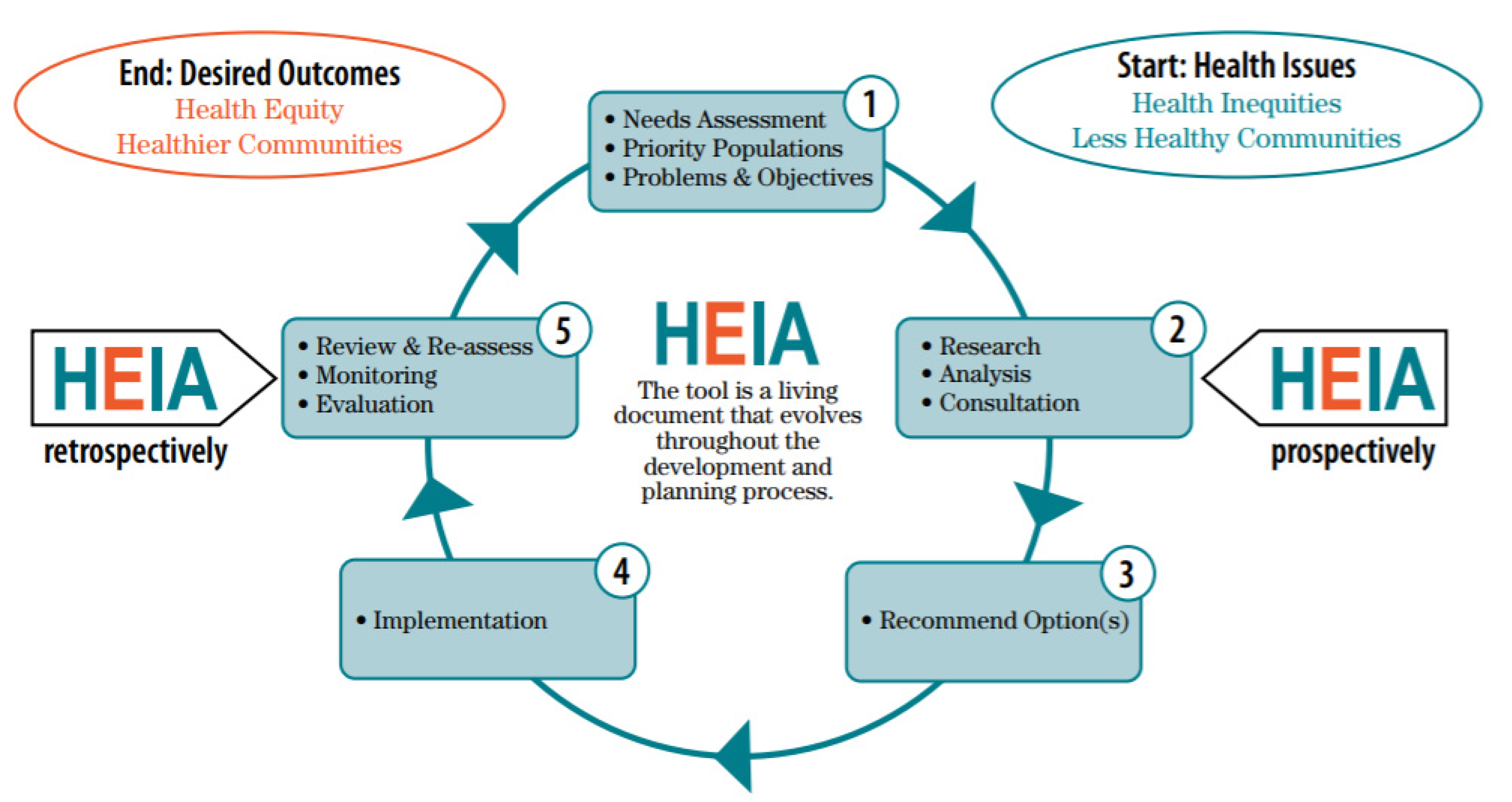
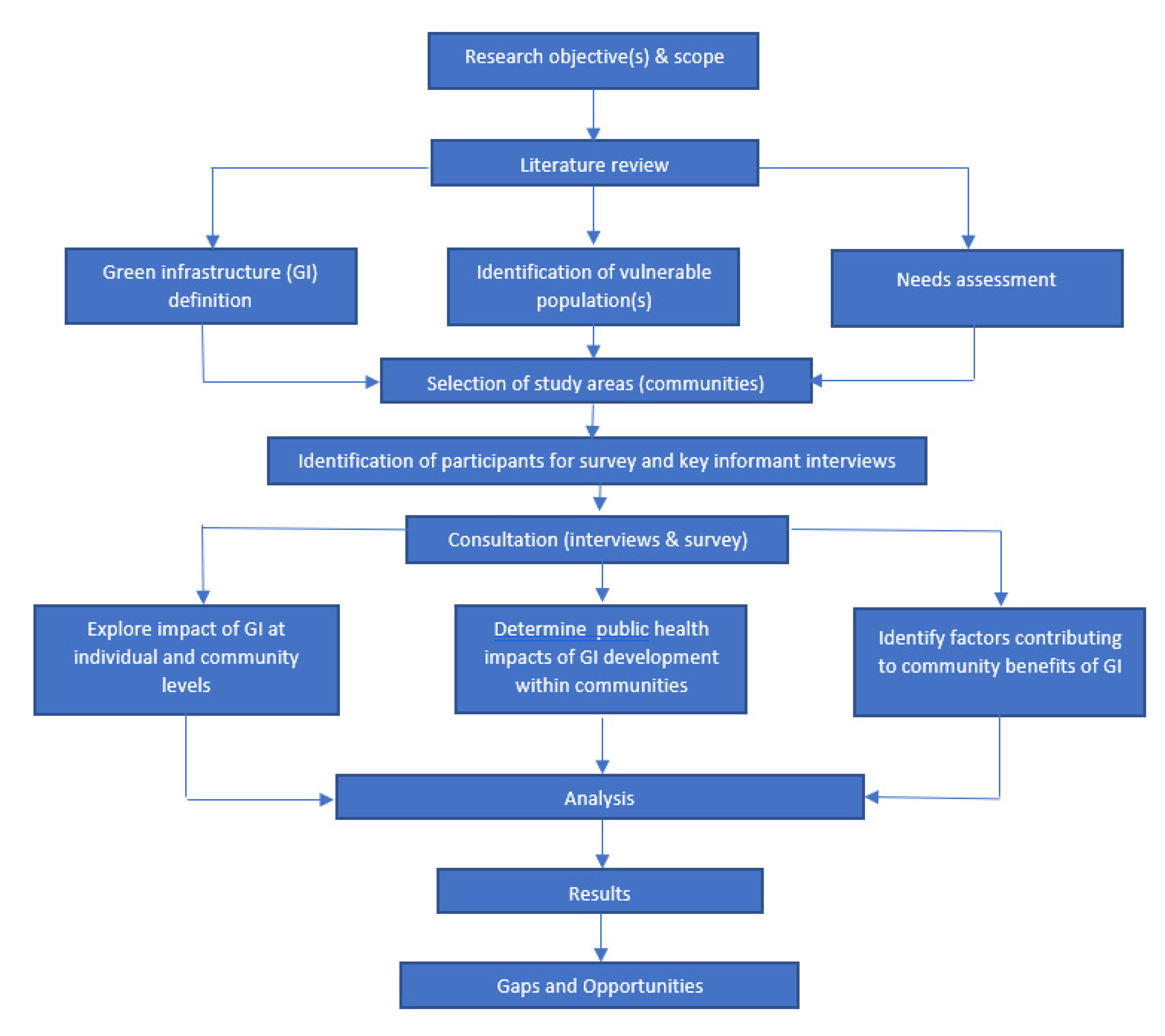

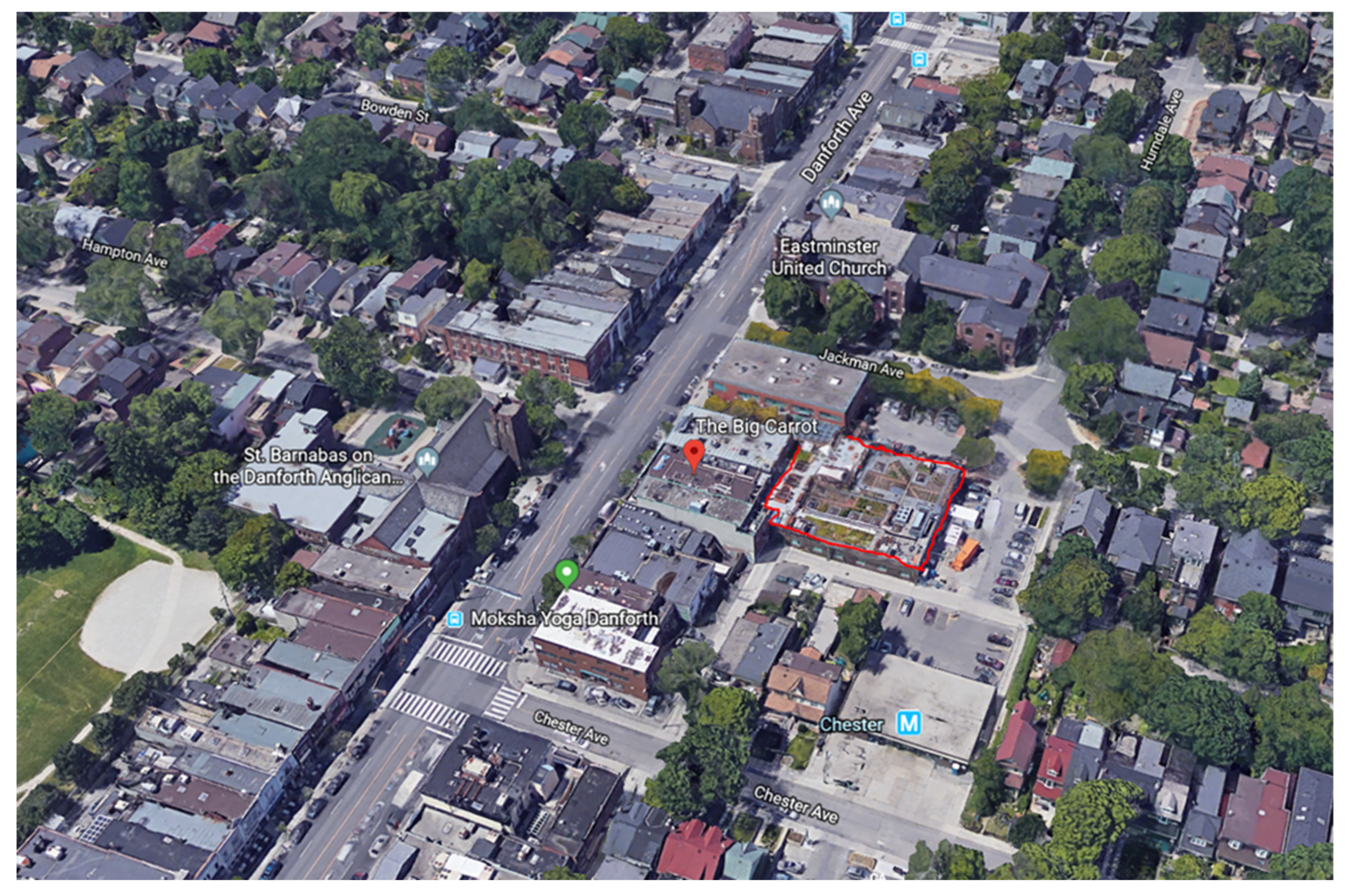
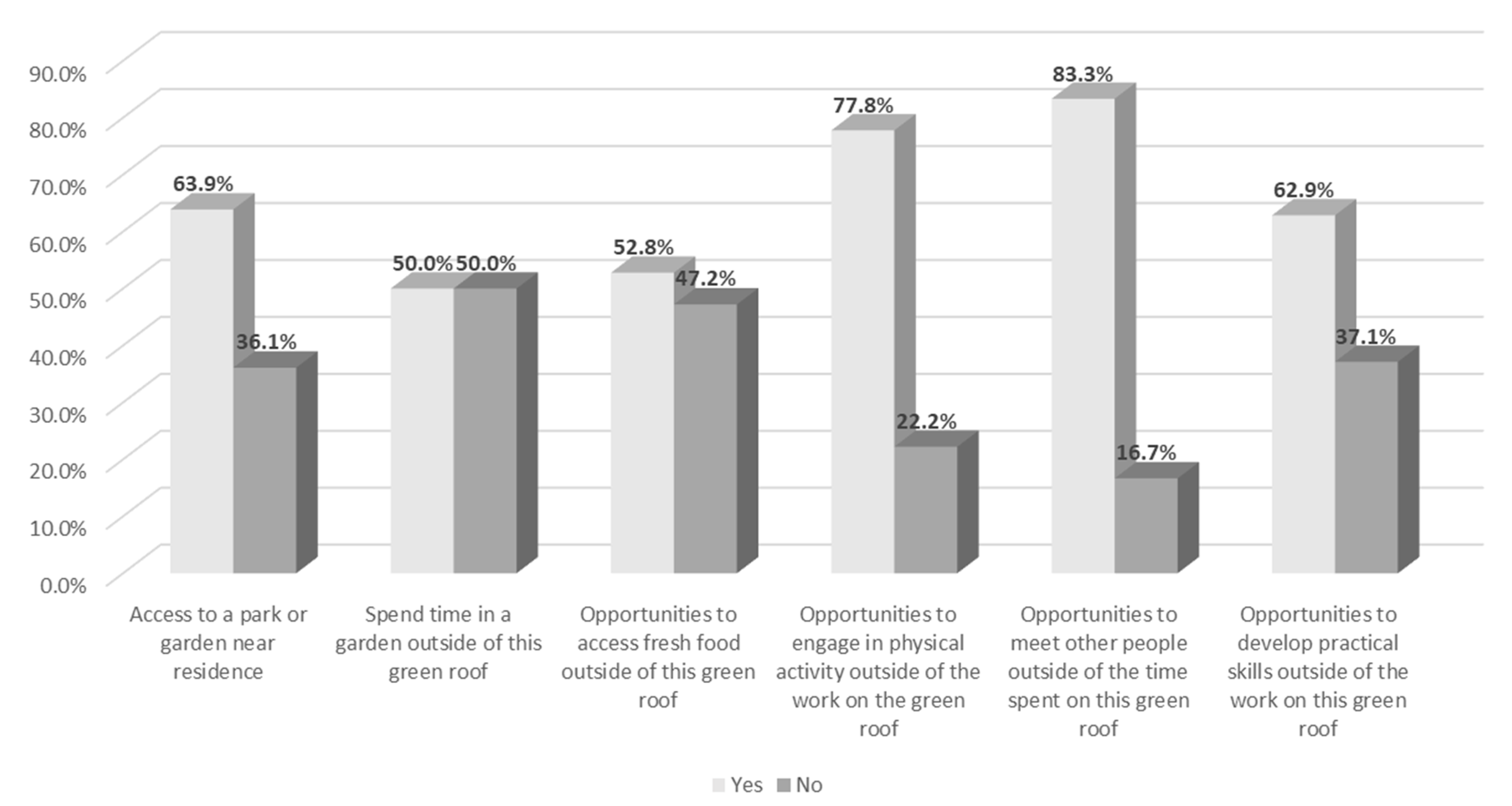
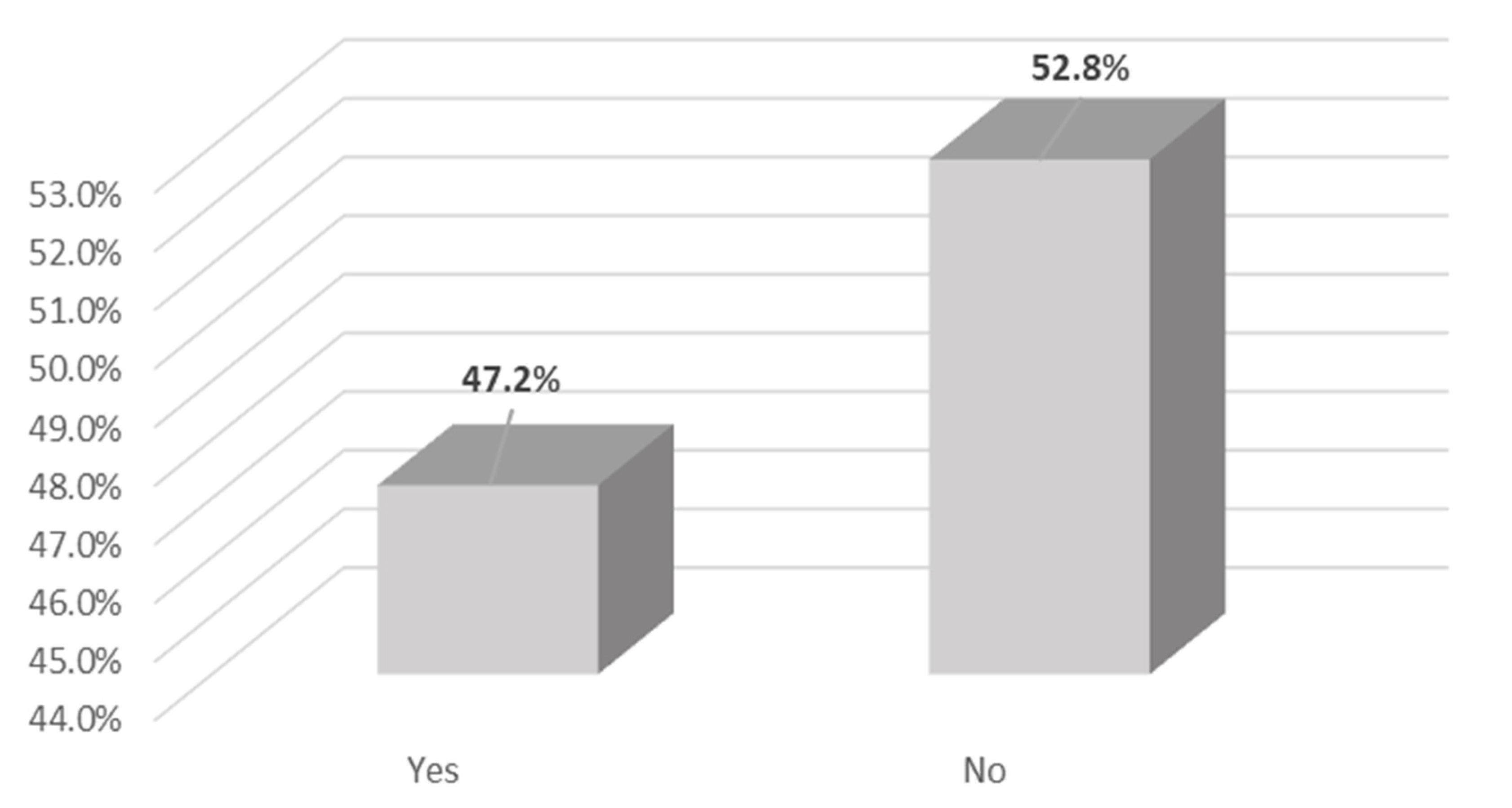
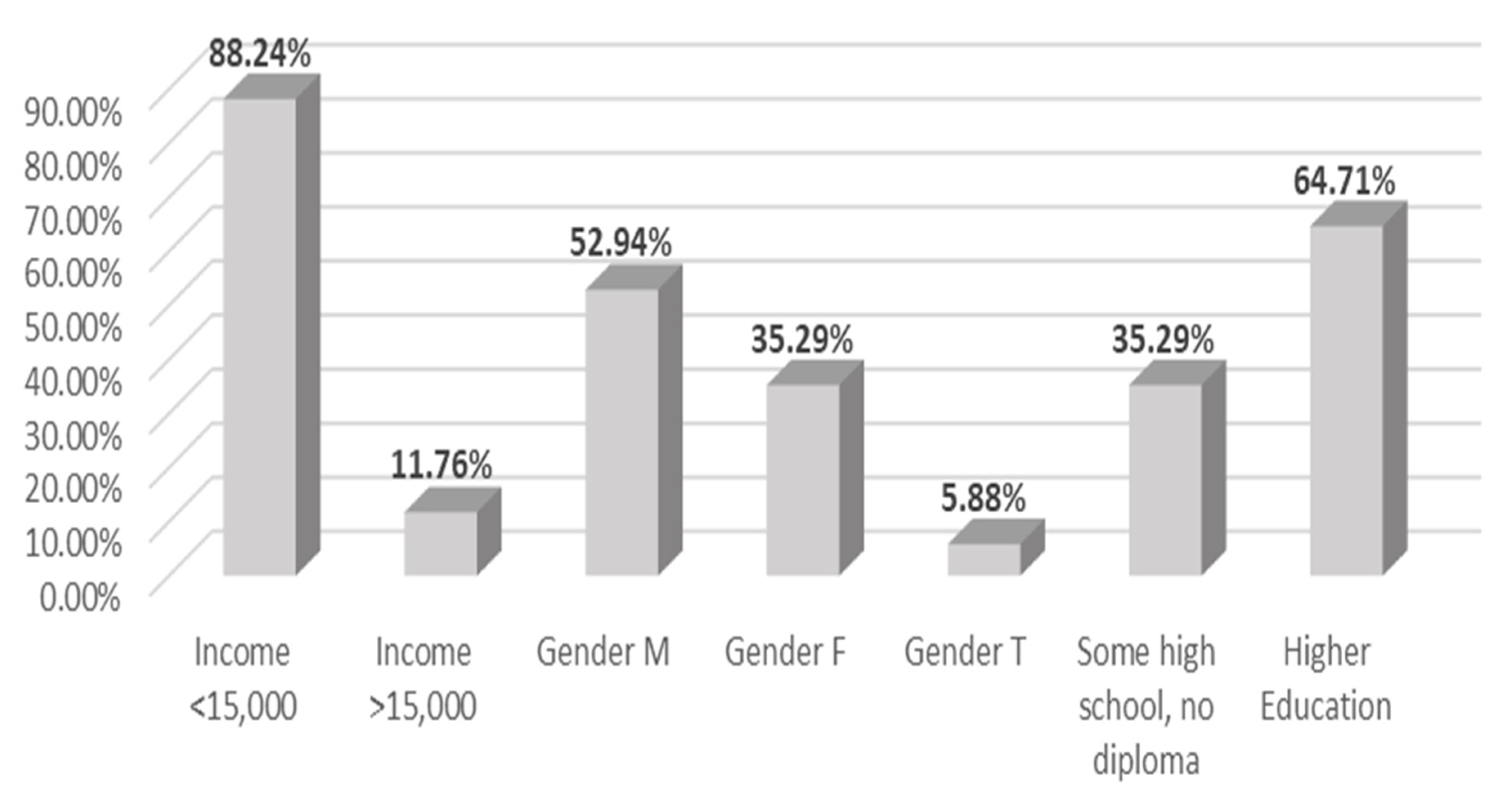
| Public Health Unit | Number Invited | Number Interviewed |
|---|---|---|
| Toronto Public Health | 1 | 1 |
| Peel Region Public Health | 1 | 1 |
| Simcoe-Muskoka District Health Unit | 1 | 1 |
| Thunder Bay District Health Unit | 1 | 1 |
| Hamilton Public Health | 1 | 3 |
| York Region Public Health | 1 | 1 |
Publisher’s Note: MDPI stays neutral with regard to jurisdictional claims in published maps and institutional affiliations. |
© 2021 by the authors. Licensee MDPI, Basel, Switzerland. This article is an open access article distributed under the terms and conditions of the Creative Commons Attribution (CC BY) license (https://creativecommons.org/licenses/by/4.0/).
Share and Cite
Anderson, V.; Gough, W.A.; Agic, B. Nature-Based Equity: An Assessment of the Public Health Impacts of Green Infrastructure in Ontario Canada. Int. J. Environ. Res. Public Health 2021, 18, 5763. https://doi.org/10.3390/ijerph18115763
Anderson V, Gough WA, Agic B. Nature-Based Equity: An Assessment of the Public Health Impacts of Green Infrastructure in Ontario Canada. International Journal of Environmental Research and Public Health. 2021; 18(11):5763. https://doi.org/10.3390/ijerph18115763
Chicago/Turabian StyleAnderson, Vidya, William A. Gough, and Branka Agic. 2021. "Nature-Based Equity: An Assessment of the Public Health Impacts of Green Infrastructure in Ontario Canada" International Journal of Environmental Research and Public Health 18, no. 11: 5763. https://doi.org/10.3390/ijerph18115763
APA StyleAnderson, V., Gough, W. A., & Agic, B. (2021). Nature-Based Equity: An Assessment of the Public Health Impacts of Green Infrastructure in Ontario Canada. International Journal of Environmental Research and Public Health, 18(11), 5763. https://doi.org/10.3390/ijerph18115763







